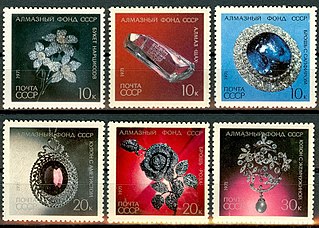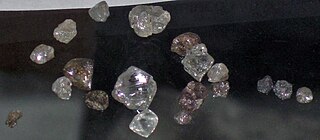
Diamond is a solid form of the element carbon with its atoms arranged in a crystal structure called diamond cubic. Diamond as a form of carbon is a tasteless, odourless, strong, brittle solid, colourless in pure form, a poor conductor of electricity, and insoluble in water. Another solid form of carbon known as graphite is the chemically stable form of carbon at room temperature and pressure, but diamond is metastable and converts to it at a negligible rate under those conditions. Diamond has the highest hardness and thermal conductivity of any natural material, properties that are used in major industrial applications such as cutting and polishing tools. They are also the reason that diamond anvil cells can subject materials to pressures found deep in the Earth.

Severodvinsk is a city in the north of Arkhangelsk Oblast, Russia, located in the delta of the Northern Dvina, 35 kilometers (22 mi) west of Arkhangelsk, the administrative center of the oblast. As of the 2021 Census, the population was 157,213. Due to the presence of important military shipyards, Severodvinsk is an access-restricted town for foreign citizens. A special permit is required.

The Argyle Diamond Mine was a diamond mine located in the East Kimberley region in the remote north of Western Australia. Argyle was at times the largest diamond producer in the world by volume, although the proportion of gem-quality diamonds was low. It was the only known significant source of pink and red diamonds, and additionally provided a large proportion of other naturally coloured diamonds, including champagne, cognac and rare blue diamonds.

Clay minerals are hydrous aluminium phyllosilicates (e.g. kaolin, Al2Si2O5(OH)4), sometimes with variable amounts of iron, magnesium, alkali metals, alkaline earths, and other cations found on or near some planetary surfaces.

The Ekati Diamond Mine, often simply called Ekati, is Canada's first surface and underground diamond mine and is owned by Burgundy Diamond Mines. It is located 310 km (190 mi) north-east of Yellowknife, Northwest Territories, and about 200 km (120 mi) south of the Arctic Circle, near Lac de Gras. Until 2014, Ekati was a joint venture between Dominion Diamond Mines (80%), Chuck Fipke, and Stewart Blusson, the two geologists who discovered kimberlite pipes north of Lac de Gras. Fipke and Blusson each held 10% stake in the mine, until Fipke sold his share to Dominion. In 2021, Arctic Canadian Diamond Company Ltd. acquired the Ekati Diamond Mine with associated assets and liabilities from Dominion Diamond Mines. In July 2023, Burgundy Diamond Mines purchased full control of Arctic Canadian Diamond Company.
Jagersfontein is a small town in the Free State province of South Africa.

Demantoid is the green gemstone variety of the mineral andradite, a member of the garnet group of minerals. Andradite is a calcium- and iron-rich garnet. The chemical formula is Ca3Fe2(SiO4)3 with chromium substitution as the cause of the demantoid green color. Ferric iron is the cause of the yellow in the stone.

Mineral processing is the process of separating commercially valuable minerals from their ores in the field of extractive metallurgy. Depending on the processes used in each instance, it is often referred to as ore dressing or ore milling.

Saponite is a trioctahedral mineral of the smectite group. Its chemical formula is Ca0.25(Mg,Fe)3( 4O10)(OH)2·n(H2O). It is soluble in sulfuric acid. It was first described in 1840 by Svanberg. Varieties of saponite are griffithite, bowlingite and sobotkite.

Alrosa is a Russian group of diamond mining companies that specialize in exploration, mining, manufacture, and sale of diamonds. The company leads the world in diamond mining by volume. Mining takes place in Western Yakutia, the Arkhangelsk region, and Africa. Alrosa is Russia's leading diamond mining and distribution company, accounting for 95% of Russian diamond production and 27% of global diamond extraction.

The Mir mine, also called the Mirny mine, is an open pit diamond mine located in Mirny, Sakha Republic, in the Siberian region of eastern Russia. The mine is more than 525 meters deep, has a diameter of 1,200 m, and is one of the largest excavated holes in the world.

The Diamond Fund is a unique collection of gems, jewelry and natural nuggets, which are stored and exhibited in the Kremlin Armoury in Russia. The Fund was opened in 1967 and its collection dates back to the Russian Crown treasury instituted by Emperor Peter I of Russia in 1719.

The Mining industry of Ghana accounts for 5% of the country's GDP and minerals make up 37% of total exports. Gold contributes over 90% of the total mineral exports. Thus, the main focus of Ghana's mining and minerals development industry remains focused on gold. Ghana is Africa's largest gold producer, producing 80.5 t in 2008. Ghana is also a major producer of bauxite, manganese and diamonds. Ghana has 20 large-scale mining companies producing gold, diamonds, bauxite and manganese; over 300 registered small scale mining groups; and 90 mine support service companies. Other mineral commodities produced in the country are natural gas, petroleum, salt, and silver.
The mineral industry of Russia is one of the world's leading mineral industries and accounts for a large percentage of the Commonwealth of Independent States' production of a range of mineral products, including metals, industrial minerals, and mineral fuels. In 2005, Russia ranked among the leading world producers or was a significant producer of a vast range of mineral commodities, including aluminum, arsenic, cement, copper, magnesium compounds and metals, nitrogen, palladium, silicon, nickel and vanadium.

Petra Diamonds Ltd is a diamond mining group headquartered in Jersey. Petra own one of the world's most productive mines historically, the Cullinan Diamond Mine is famed for having produced the world's largest rough and polished diamond. The company is listed on the London Stock Exchange.

The Central African Republic's mineral resource endowment includes copper, diamond, gold, graphite, ilmenite, iron ore, kaolin, kyanite, lignite, limestone, manganese, monazite, quartz, rutile, salt, tin, and uranium. Of these commodities, only diamond and gold were produced in 2006 - subsistence farming was the mainstay of the economy.

Kelsey Lake Diamond Mine is a defunct diamond mine in Colorado, USA. It is located in the State Line Kimberlite District, near the Wyoming border, and consists of nine kimberlite volcanic pipes, of which two were open pit mined.
The mining industry of Lesotho is mostly concentrated on diamond mining and as such the mining sector in the country has not played any significant role in furthering its economy. Apart from diamonds, the country's main mineral resources have been identified as base metals, clays, dimension stone, sand, gravel and uranium. The lack of initiative to extract other minerals commercially is mainly attributed to the inadequacy of infrastructure and finances. Between 2000 and 2011, the percentage of GDP contributed by diamond mining to Lesotho's economy rose from "virtually zero" to about 4%.
JSC «Severalmaz» is a Russian diamond mining company. It is a subsidiary of JSC "Alrosa" and holds a license for Europe's largest Lomonosov diamond mine, in Arkhangelsk Oblast, with reserves of 220 million carats of rough diamonds. Production in 2009 amounted to 500,000 carats of rough diamonds.
The Arctic zone of the Russian Federation is the territory of the Extreme North, which is the largest among the Arctic states. It includes the land part, water area and continental shelf of the seas of the Arctic Ocean. If we take the Arctic Circle as the southern boundary of the Arctic, it covers an area of over 9 million km^2, of which almost 7 million km^2 is in the water area. In the Russian Arctic, territory mastered by man beyond the Arctic Circle and near it, as well as reserves of untouched nature, coexist. The territories of the following subjects of the Russian Federation - the Arkhangelsk, Murmansk regions, the Republic of Sakha (Yakutia), the Krasnoyarsk Territory, the Nenets, Yamalo-Nenets and Chukotka Autonomous Districts, the Komi Republic with a population of over 1 million people - are fully or partly included in the Arctic zone.

















